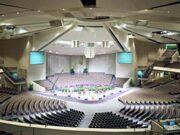Defined not only by their large membership but also by a wide variety of social and organizational characteristics, megachurches are a twentieth- and twenty-first-century religious phenomenon marked by the use of contemporary American culture in both ministerial and evangelical work. Though megachurches represent only a relatively small portion of total congregations in the United States—only 1 percent of American churchgoers in 2004 attended megachurches—they have become important on the religious landscape of the nation and of Georgia in particular.
What Makes a Church a Megachurch?
In general megachurches are much larger than traditional congregations, often averaging thousands of weekly attendants. Size, however, varies greatly among megachurches; some attract only a few thousand attendants, while others regularly draw between 15,000 and 20,000 people each week. Churches with the largest congregations in the state include New Birth Missionary Baptist Church of Lithonia, North Point Community Church of Alpharetta, World Changers Church International of College Park, and First Baptist Church of Woodstock. Smaller megachurches in Georgia include Hebron Baptist Church of Dacula, First United Methodist Church of Marietta, Savannah Christian Church of Savannah, and Cascade Baptist Hills of Columbus.
Besides their large size, megachurches share other characteristics. Nearly all are Protestant and evangelical. Some retain ties to Baptist, Methodist, Pentecostal, or Presbyterian denominations, but many consider themselves nondenominational. The demography of megachurch congregations likewise varies, but since their first emergence in the 1950s, they have tended to attract people who are young or middle-aged, white, suburban, well educated, middle-class, conservative, and family oriented. Since the 1980s, however, increasing numbers of megachurches also have drawn attendants from working-class and minority populations.
The founder of the church—who typically doubles as a dynamic preacher—often directs institutional affairs. Most megachurch pastors envision a “strategic vision of growth” for the church and depend on a combination of associate pastors, directors, deacons, or staff members to implement that vision. Additional growth usually results from the church’s ability to offer a wide selection of attractive programs, including worship services, day care, youth programs, recreational activities, Sunday school classes, and small group Bible studies. Enormous budgets, some reaching tens of millions of dollars, keep such programs fully staffed, funded, and running year round.
Megachurches and Contemporary American Culture
Though most often conservative or fundamentalist in their theological orientation, megachurches borrow extensively from modern American culture to attract and retain congregants. Megachurches often intentionally mirror modern corporate architecture, drawing in visitors and members alike with well-manicured landscaping, ample parking, shuttle services, attractive concourses, information centers, and even gift shops. Pastors, to varying degrees, often supplement pragmatic sermons with multimedia presentations, contemporary slang, or anecdotes taken from popular culture. Worship services incorporate the latest technology and theatrical techniques, including dramatic lighting, state-of-the-art sound systems and amplified instruments, wide-screen displays, and television feeds to off-site “satellite” churches. Taken together, the use of such recognizable aspects from modern American culture presents the church to visitors as a new, exciting, and attractive way to spend a Sunday morning and potentially develop personal ties to the church community.

Courtesy of Savannah Christian Church
Megachurches in Georgia
As of 2006, Georgia had eighty megachurches, the fourth highest number in the United States. With several notable exceptions, most of these churches are located in the Atlanta metropolitan area. As with most megachurches nationwide, those in Georgia vary greatly in size, demography, denominational affiliation, and theological preference. Some, such as First Baptist, New Hope Baptist, Mount Pisgah United Methodist, Peachtree Presbyterian, and Roswell Street Baptist, are large churches with long histories in the area and clear ties to national or regional denominations.
Several African American churches, such as St. Philip AME Church in Atlanta and New Birth Missionary Baptist, have likewise grown from smaller congregations into larger bodies. Other megachurches, such as Free Chapel Worship Center in Gainesville, represent a national trend in recent American religious history toward a more Pentecostal or charismatic tradition. A growing number of younger congregations—North Point Community Church, Crossroads Community Church, and Victory World Church, all in the metropolitan Atlanta area—show an obvious preference for nondenominationalism.
Regardless of their particular features, megachurches in Georgia emulate the characteristics of other such congregations scattered across the country. They are large, modern, highly organized, and increasingly popular religious communities committed to future growth. How well they succeed in their vision remains to be seen, but the presence of megachurches on the religious landscape of the state and nation appears secure.






